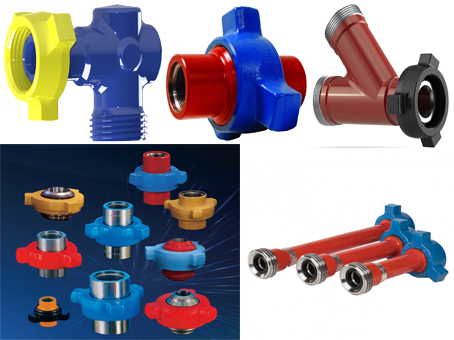
Types of connections:
- Oil Field Unions
- Pup Joints
- Flanges
Due to the fact that we face high pressure in the oil and gas drilling industry, so for connections, equipment with standards approved by the oil industry is used to reduce the risk of problems during operation. Alloy is the manufacture of parts and is one of the important items in this section. Some of the most commonly used parts include the following, which are briefly stated:
Types of Hammer Union: These connections are both threaded and welded, which are usually used for high pressures of Psi 5000 and conditions where the H2S environment is higher than standard.
Pup Joint: Another type of connection that is separate from the two threaded or welded parts in two have pipes with different lengths and patterns. These connections are sometimes made resistant to pressures above 100,000 Psi, which is at the request of the employer and according to the needs of the consumer.
Types of Flange: Flanges are one of the most important connections in the oil and gas drilling, petrochemical and refining industries. They are a type of connecting pipes, valves and devices to each other. The flanges are disc-shaped pieces, which are often connected in pairs using bolts and nuts, are easy to open, and are suitable for low and high pressures.
Flanges are among the connections that connect the transmission pipelines (with any type of fluid) to each other, as well as the valves to the welded pipes. Flanges are often made of polyethylene, steel, steel, iron or cast iron. Flanges are divided into different classes depending on the material to withstand the pressure they withstand.
1- Blind Flange:
A closed round plate used at the end of piping and pressure paths. This type of flange, as well as its screws, generally withstands more pressure than other flanges, with the maximum pressure at its center. Depending on the flange class, it can withstand proportional pressure.
2- Weld Neck Flange:
The rotating flange has a conical neck whose radius is equal to the diameter of the tube at the end and is welded to it. The presence of this neck strengthens the flange endurance. This type of flange is suitable for withstanding high pressures and sub-zero temperatures as well as oscillating and vibrating loads.
3- Slip on Flange:
This type of flange is used in ordinary services. It is easy to install and its resistance to internal pressure is two thirds and to the fatigue load one third of the neck flange and its installation cost is a bit higher.
4- Lap joint Flange:
It is like a normal flange with no bottom layer and the end is chamfered and the pipe is butt welded at the other end. This flange has no contact with the fluid and its cost is one third more than a rotating flange and its stress resistance is only one tenth of a rotating flange.
5- Socket weld flange:
As the name implies, this flange has a chamber into which the pipe is placed. If this flange is welded from the inside, its fatigue resistance will be one and a half times and its static resistance will be equal to the slip on flange.
6- Screw Flange:
The inside of these flanges is threaded and the pipe can be screwed into it. One of the advantages of these flanges is that they do not need welding. Of course, if necessary and high pressures, welding can also be used in them. The performance of these flanges is at high pressures.
7- Orifice Flange:
This flange is actually a rotating flange and in some cases a surface that has a hole in the radius. These holes are used to measure the flow of a liquid or gas.
